Caring for archaeological collections
Charlotte Newton and Clifford Cook
Caring for archaeological collections is part of CCI's Preventive conservation guidelines for collections online resource. This section presents key aspects of managing the care of archaeological objects in heritage collections based on the principles of preventive conservation and risk management.
Table of contents
- Understanding archaeological collections
- Causes of damage to archaeological collections and preventive conservation strategies
- Examples of preventive conservation practices
- Bibliography
List of abbreviations
- 3-D
- three-dimensional
- CCI
- Canadian Conservation Institute
- CDs
- compact discs
- DNA
- deoxyribonucleic acid
- DVDs
- digital versatile discs
- HVAC
- heating, ventilation and air conditioning
- portable document format
- RH
- relative humidity
Understanding archaeological collections
Archaeological collections are as varied and diverse as the eras and cultures that they represent, but there are some specific characteristics and problems that make them different from other museum collections. Archaeological collections, which contain objects that were excavated after having spent a prolonged period of time underwater or within the earth, often include a wide variety of materials and a large number of objects or fragments of objects. The condition of the objects will usually have been altered both by use and by burial conditions. In addition to the objects themselves, an archaeological collection can include a variety of associated materials, such as soil or pollen samples, and is almost always accompanied by a related archive that can be made up of many types of documentation. The care of archaeological objects begins with decisions made in the field and extends for decades or centuries after the objects enter a collection in a museum or repository.
Specific problems of archaeological collections
Diversity of the collections
The variety of materials in a collection will depend on the technology available to the culture that produced the objects. In Canada, pre-contact sites can include materials such as low-fired ceramics, wood, skin, stone, textile, basketry, bone, ivory, horn, antler, baleen and some metals (native copper, meteoric iron), while historic (post-contact) period sites may have, in addition to these materials, glass, higher-fired ceramics and smelted metals, notably large amounts of iron in the form of nails, tools and building hardware, as well as lead and copper alloys. More recent sites can also include modern materials such as plastics, vulcanized rubber and aluminum. This wide variety of materials will require differing environmental conditions for storage and display.
Objects are just one part of an archaeological collection. It can also include environmental samples (soil, pollen, insects); materials related to human activity but not man-made (faunal remains); molds, casts or reproductions of site features (soil section transfers, etc.; Figure 1); or reproductions of objects. In addition, archaeological records in paper or electronic format, such as field notes, photographs, analysis results and the final report, must also be preserved as integral parts of the collection. The information contained in these records is essential in establishing the significance of an object in terms of its historical context as well as its connection to the rest of the site.

© Government of Canada, Canadian Conservation Institute. CCI 129980-0001
Figure 1. Reproduction of an oven from Red Bay, Labrador. Polysulfide rubber was used for the mold of this archaeological feature, with plaster of Paris mother molds. The reproduction was cast in epoxy resin and then painted. The diversity of materials and the size of the reproduction make storage a challenge.
Collection size and management
Even relatively small sites can produce thousands of objects, while large multi-year excavations may bring forth hundreds of thousands or millions of objects. Under the terms of the archaeology permit, all of these objects or fragments may have to be documented, numbered, preserved and put into storage. For this reason, planning for preservation will usually need to begin before excavation and certainly before the objects arrive at a museum or repository.
Effects of use and burial
How an object was used during its lifetime can affect how well it stays preserved during burial. An object may have undergone wear, deterioration or contamination during its period of use, making it vulnerable to further damage. The special conditions found in underwater sites, arctic permafrost or wet bogs can yield large quantities of well-preserved objects; however, most other burial environments will have fostered deterioration. During burial, archaeological objects may be surrounded by oxygen, microorganisms and moisture as well as salts or other contaminants in the environment, which slowly degrade the objects. Soil types like clay, sand, gravel or peat, as well as moisture levels, including dry, damp and wet, can affect the condition of buried objects. All types of material will begin to deteriorate, with organic materials normally deteriorating more severely.
However, permafrost or underwater burial conditions help to preserve almost all materials, in particular organics like wood, leather and textiles. During burial, most objects will experience a period of rapid or extensive degradation initially. This is followed by a longer period in which the object nearly reaches equilibrium with its environment and deterioration gradually slows down until the moment of excavation, when exposure to a new environment accelerates the process again (Figure 2). This renewed deterioration can be minimized by on-site conservation efforts that can include preventing rapid change to the moisture content of the object, blocklifting fragile objects when removing them from the soil so as to support them properly, and transporting objects to a conservation laboratory as soon as possible.
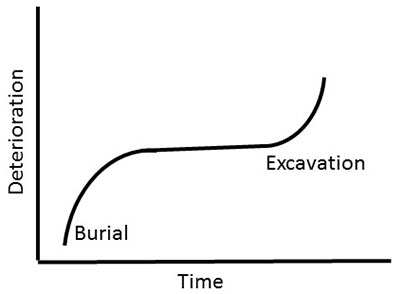
© Government of Canada, Canadian Conservation Institute. CCI 129980-0003
Figure 2. Generalized graph depicting the rate of deterioration of objects from the time of their initial burial to the period following their excavation.
Objects as scientific evidence
Archaeological objects and samples are frequently used for different purposes in scientific studies, i.e. for dating; to identify materials, processes or species; in health and nutrition research; or in DNA analysis, among other things. If the objects or samples are to be useful for scientific analysis, it is vital for them not to be contaminated during or after excavation with foreign materials that could interfere with analysis.
Causes of damage to archaeological collections and preventive conservation strategies
Once the excavation is completed, archaeological objects housed in collections are vulnerable to all 10 agents of deterioration to different degrees, depending on the materials and their condition. The agents that particularly threaten these types of collections, due to the vulnerabilities of their archaeological nature, are physical forces, thieves and vandals, dissociation, incorrect temperature and incorrect relative humidity (RH). Archaeological materials also face specific issues related to their environment during burial and immediately after excavation. For information on mitigating other general risks, consult Agents of deterioration.
Deterioration during burial
In certain burial conditions, there may be exceptional preservation of objects. Organic materials (e.g. wood, skin and leather, feathers, bone, ivory, textile, horn, antler, baleen) are best preserved in very wet, very dry, frozen or low-oxygen burial environments. In these conditions, the materials are protected from biological activity (e.g. bacteria, mould, insects, animals).
Organic materials are poorly preserved on sites where there are seasonal freeze-thaw cycles, changes in water level or where the soil is well-drained and oxygenated. This often results in very few organic materials being found, and those that are found are in poor condition (weaker and fragmented) and, in extreme cases, only traces of the objects remain.
The pH of the burial environment will also influence the preservation of organic materials. Protein-based materials, such as wool and leather, are well preserved in mildly acidic conditions (such as peat bogs), while cellulosic materials, such as cotton, linen and even wood, are better preserved in slightly basic soils and will deteriorate under acidic conditions. Attack by insects and infiltration from plant roots can also damage the buried objects.
Some materials, for example certain types of stone and ceramic, are largely impervious to burial conditions and will survive well in most environments. Most inorganic materials (e.g. metal, stone, ceramic, glass) will be damaged by the presence of salts in the burial environment, which will leach into the materials. Iron will corrode rapidly in the presence of chloride salts, water and oxygen. Stone and ceramic may be damaged by salts during repeated wet and dry periods, as salts can migrate inside these materials and then crystallize during dry periods, causing physical disruptions. Water in the soil or at wet sites can leach away components of glass, particularly poorly formulated glass, and leave it fragile and deteriorated.
Deterioration during excavation
When objects are excavated, they are suddenly exposed to a new set of environmental conditions and are at risk of rapid deterioration. There is a rapid change in moisture, light and oxygen levels, which can cause physical, chemical and biological changes in the objects. As well, many fragile objects will collapse if removed from the soil surrounding them, which was providing physical support. It is particularly important, before excavation, to anticipate these changes in the environment and their potential dire consequences on the objects during excavation and to plan accordingly. This may involve providing physical support to objects during excavation and temporary storage conditions that duplicate the burial conditions as nearly as possible. A conservator should be involved before excavation to provide advice or on-site support, if needed.
If organic materials (e.g. wood, skin and leather, bone, ivory, textile, horn, antler, baleen, basketry) have survived burial, it will be because of exceptional conditions. When the objects are excavated, there will be a sudden and drastic change in these conditions that can result in irreparable damage. Objects should be kept in conditions which approximate that of burial: objects that were found wet should be kept wet, objects found in permafrost should be kept frozen, and so on. Wet organic materials may resemble fresh, undeteriorated materials, but they are never completely unaffected by burial. If wet organic materials are allowed to dry in an uncontrolled way, there will often be irreversible shrinking, distortion, cracking or collapse. Freshly excavated wet organic materials are vulnerable to biological attacks, particularly mould, due to increased temperatures, oxygen and light. Large or fragile objects will be vulnerable to breakage if they are excavated and handled without being supported. On northern sites, sphagnum moss can be used to pack newly excavated wet objects: the moss keeps them wet and supported and reduces the likelihood of mould growth (Figures 3 and 4).

© Government of Canada, Canadian Conservation Institute. CCI 0000609-0001
Figure 3. Sphagnum moss is readily available in many parts of northern Canada, making it a convenient packing material on remote sites. Fragile wet wooden objects are placed on damp sphagnum moss, on a corrugated plastic board. The sphagnum moss cushions and supports the objects and keeps them damp during storage and transportation.

© Government of Canada, Canadian Conservation Institute. CCI 0000609-0002
Figure 4. After the steps described in Figure 3, the objects are covered in a layer of sphagnum moss and enclosed in plastic wrap and then aluminum foil to prevent drying. The damp moss around the objects helps to keep the wood wet and has a natural biocide that reduces the risk of mould growth.
Inorganic objects, such as metal, glass and ceramics, can also undergo chemical changes after excavation. Metals covered in concretions or contaminated with salts should not be allowed to dry before undergoing conservation treatment. Drying and the increased exposure to oxygen will allow the corrosion to oxidize to a harder, more difficult-to-remove corrosion product, and contaminating salts will be more difficult, if not impossible, to remove. Severely deteriorated glass may look fine when wet but may go opaque or even physically disintegrate as water within the glass matrix evaporates. Thus, freshly excavated glass must not be allowed to dry out. Even archaeological glass from dry desert sites may undergo this transformation.
Archaeological materials often go into storage after being cleaned of surface dirt and studied by the staff carrying out the excavation. The vast majority of these items in museum collections have not undergone treatment to remove salts or stabilize them in any way. This makes them particularly vulnerable in a poor storage environment. For example, if a storage area has a high humidity, metal objects will typically corrode more rapidly. If a storage area has sudden drops in RH, salt-contaminated ceramics, glass and stone objects may develop salt crystals on their surface or spalling surfaces.
Post-excavation (in the repository): vulnerabilities and preventive conservation strategies
Physical forces
Archaeological objects are often more fragile than they appear and may be easily damaged by incautious handling or insufficient support. Brittle objects, such as glass and ceramics, have a high risk of breakage, which may greatly and irreversibly affect their appearance. Ceramic, glass and metal objects can be easily scratched. Organic materials may sag, rip or crease if not supported to counter the effects of gravity. Areas repaired in the past often remain fragile and may not be immediately apparent. These are just a few of the reasons why objects should be handled with caution, regardless of their appearance.
Accidental breakage is the most common form of damage to objects and causes new problems, as small loose pieces can become dissociated from the main portion. Moving objects in a tray (Figure 5) or, better yet, on a cart (Figure 6) will reduce the risk of breakage. All types of archaeological objects should be stored in boxes, bags, drawers, etc. to protect them from dust (Figures 7 and 8); this reduces the need to clean them and thus handle them, thereby also reducing risks of accidental breakage. Collections with a large number of objects require well-organized storage, sufficient space and good inventory control to reduce the need for repeated handling in order to locate or monitor objects (Figure 9). Most of the time, archaeological objects on display require custom supports (Figure 10).

© Government of Canada, Canadian Conservation Institute. CCI 129980-0007
Figure 5. The object is protected from direct handling and impact by the padded tray. The ring support for the object prevents it from rolling on the tray.

© Government of Canada, Canadian Conservation Institute. CCI 129980-0008
Figure 6. Objects are particularly vulnerable when being handled or transported. Using trolleys reduces risks. Plan the move in advance, making sure that the object is supported and protected, that the route is unobstructed and that there is a spot ready to receive the object.

© Government of Canada, Canadian Conservation Institute. CCI 129980-0009
Figure 7. Objects stored in drawers can be easily examined (e.g. for renewed deterioration) and retrieved, if needed. They are also protected from dust and abrasion.

© Government of the Northwest Territories, Prince of Wales Northern Heritage Centre. R. Scott
Figure 8. Objects stored in a box with dividers. Boxes eliminate light and dust and simplify handling, retrieval and inventory control. Dividers, which serve to prevent objects from bumping against each other when moved during handling, are mobile and can be modified to suit different types of objects or collections.

© Government of the Northwest Territories, Prince of Wales Northern Heritage Centre. R. Scott
Figure 9. A compact storage system with adjustable shelves for storing boxes allows for the maximum use of accessible space.

© Government of Canada, Canadian Conservation Institute. CCI 69345-0017
Figure 10. A custom display mount for a ceramic jug.
Recommendations
- Do not stack objects, as stacking could lead to crushing due to excessive weight.
- Protect objects from scratching against other surfaces. Keep them wrapped or individually contained (in boxes, bags, etc.) to isolate them from other harder surfaces.
- Support materials from their base during handling, storage and display because burial might have weakened them and rendered them fragile. Larger, flexible objects, such as textiles, may need a rigid support when moved.
- Never pick up objects by handles, spouts or other projections since these could break off.
- Always use two hands when lifting an object.
- Store objects on padded shelves with adequate support and padding to prevent movement or distortion such as sagging or creasing under their own weight.
- When storing objects in drawers, separate small objects with padding to keep them from rolling or rubbing against each other when drawers are opened and closed.
- Cover open shelving units. Preventing dust build-up will reduce the need to clean objects and will thus reduce handling.
- Consider installing soft flooring as opposed to concrete in storage areas.
- When moving an object, use a cart with large diameter wheels rather than carrying it.
Consult Handling heritage objects for more guidance on preventing damage from handling. For more information on protecting collections from physical forces, consult Agent of deterioration: physical forces.
Thieves and vandals
Some smaller archaeological objects (e.g. coins, jewellery, ivory carvings, some ceramics and some glass) are attractive and collectible. They may be targeted by professional thieves, but a more common risk is that they could be seen as tempting items for opportunistic thieves when they are displayed or stored in an unsecured manner.
Recommendations
- Ensure a high level of security for small valuable items, e.g. display them behind glass or secure them with ties to a mount.
- Keep control of objects during study, display and loan by limiting access to them and carefully recording their movements. Also, record the identifying information of visiting researchers working with the collection.
Consult Agent of deterioration: thieves and vandals for details on security measures for protecting heritage collections from theft and vandalism.
Dissociation
Small objects are easy to move, misplace and lose. In large collections with many fragmentary objects, there is a risk of unintentional loss of objects through everyday handling and movement if inventory protocols are not followed. There have been instances where underused portions of a collection from a site have been accidentally discarded (as illustrated in the second example in Vignette 1. Accidental discards under Agent of deterioration: dissociation). With the increasing use of identified central repositories and storage within museums, archaeological collections are more accessible and better protected, as opposed to being poorly stored and forgotten in warehouses, basements and garages.
It is vitally important to ensure the presence and integrity of accession numbers on objects. The common museum practice of applying a number to the surface of an object can be difficult with archaeological material. The surfaces can be rough, powdery, porous or fragile, making it difficult to apply a legible number. With time and as objects are handled, some of these numbers can become illegible or totally lost, and this leads to a loss of value of the archaeological collection.
In addition to objects and samples, an integral part of any archaeological collection is the records that accompany it. These can include labels, field notes, drawings, maps, correspondence, catalogue records, conservation records, photographs, slides, radiographs, digital images, analysis reports, video tapes, audio tapes and CDs. These records are of vital importance to the integrity of the collection. They present a number of challenges: not only can they take up a considerable amount of space, which has to be accounted for in planning space allocation, but they also require special preservation measures, much like paper and photographs in archival collections (consult Caring for paper objects and Caring for photographic materials). With electronic records, changing technology may make many of them unreadable as old playing equipment fails and cannot be repaired or software becomes obsolete.
The archaeological archive accompanying a collection may include:
- Paper documents (e.g. notebooks, logbooks, journals, correspondence, catalogue cards, site maps, drawings, photocopies, tracings, computer printouts)
- Microfilm or microfiche
- Magnetic media (e.g. audio and video tapes, computer tapes, floppy discs)
- Photographic records (e.g. colour slides, colour prints, black and white prints, negatives, X-rays)
- Digital photographs
- Cataloguing information recorded in a computer database
- Optical discs (e.g. DVDs)
- Object labels in a variety of materials (e.g. paper, polyethylene non-woven sheet [Tyvek], Dymo plastic tape)
Recommendations
- Use good documentation practices by maintaining an up-to-date database.
- Safeguard objects during study, display and loan by ensuring that all objects are labelled and by keeping all parts of an object together at all times.
- Back up digital records and follow good archival collection practices.
- Use appropriate accession numbering methods tailored for the objects and their surfaces. If possible, attach a numbered tag to the object or label the bag or box that contains the object.
More recommendations on documenting and tracking collections can be found in Agent of deterioration: dissociation.
Incorrect temperature and relative humidity
Incorrect temperature
The main concern with temperature is its large impact on RH: excessively dry or damp environments can be created as the temperature rapidly increases or decreases. Some archaeological objects are sensitive to dry environments, notably organic materials that have become physically weakened due to their past burial environment. They can dry out, become brittle, crack and split. With deteriorated skin or leather, damage due to dryness can take place at temperatures only slightly above those found in a museum.
Higher temperatures can also accelerate the aging of materials used to repair objects. Some types of adhesives will soften at elevated temperatures (above 30°C), causing joints to weaken, allowing mended objects to sag and, in extreme cases, causing adhesive failure when the object is handled.
Recommendations
- Keep sensitive objects out of direct sunlight; if window lighting must be used, choose north-facing windows.
- Protect sensitive objects from any source of heat and avoid illuminating them with incandescent lamps.
Consult Agent of deterioration: incorrect temperature for guidance on selecting appropriate temperature levels for heritage collections.
Incorrect relative humidity
When archaeological collections are exposed to high RH:
- Above 65% RH, mould can grow. Consult Agent of deterioration: incorrect relative humidity, which provides a chart indicating the rate of mould growth by humidity level.
- Corrosion advances on metal. In general, for metals, the lower the RH the better; when RH is above 75%, all corrosion greatly speeds up. Archaeological metals are among the most highly vulnerable because they are often contaminated with salts from the burial environment. This causes the metals to corrode more aggressively and at lower RH thresholds. For iron that is contaminated with salt, corrosion can take place at levels above 12% RH and increases proportionately with the RH level, becoming quite rapid at levels above 50% (Rimmer et al. 2013; Figures 11 and 12). Salt-contaminated copper and its alloys are at moderate risk of corroding at RH levels above 42%; the risk increases as the RH level rises and becomes very high at an RH above 68% (Rimmer et al. 2013, p. 11).
- Unstable glass can weep above 42% RH, resulting in damage.
When archaeological collections are exposed to low RH:
- Organic materials can dry out, become brittle and shrink.
- Unstable glass can become chemically altered, resulting in structural instability and even crizzling below 30% RH.
When archaeological collections are exposed to fluctuations in RH:
- Deteriorated organic materials are especially sensitive. Changing humidity can result in cracking, distortion and collapse. In particular, if the environment fluctuates from moderate to low RH and back, the combined effect of increased brittleness and shrinkage stresses can cause the materials to fracture, delaminate and disintegrate.
- Ceramics can spall on the surface. RH that fluctuates above or below the critical RH of salts present in a ceramic object can cause the salts to migrate and crystalize within the object, resulting in spalling of the surface. This often happens to archaeological ceramics from salty environments. Consult Figure 13 in Caring for ceramic and glass objects for an example.
- Unstable glass is at risk of weeping and crizzling. It is most stable between 30% and 42% RH and will be unstable in an environment with large RH fluctuations exceeding this range, alternating between weeping and crizzling. Consult Incorrect relative humidity under “Glass” in Caring for ceramic and glass objects for a detailed explanation.

© Government of Canada, Canadian Conservation Institute. CCI 87306-0099
Figure 11. Corroded iron. Archaeological iron that is contaminated with salt is particularly vulnerable to elevated or fluctuating humidity levels.

© Government of Canada, Canadian Conservation Institute. CCI 125773-0064
Figure 12. Corroded copper alloy. A copper alloy object that is contaminated with salt is actively corroding in high humidity.
Recommendations
- Keep organic materials below 65% RH to prevent mould growth.
- Keep unstable iron in a dry environment, always below 75% RH, preferably below 50% RH and ideally at an RH less than 12%.
- Store salty ceramics below 50% RH.
- Store unstable glass that is prone to weeping and crizzling between 30% and 42% RH with minimal fluctuations.
- Standard museum conditions can be provided by the heating, ventilation and air conditioning (HVAC) system. However, some collections may require drier conditions. For archaeological metals and especially for salt-contaminated iron, desiccated silica gel can be used to maintain a dry environment, combined with a maintenance plan that ensures that the silica gel is reconditioned when RH climbs beyond the desired level. For other types of stringent controls necessary for some collections (e.g. unstable glass best kept between 30 and 42% RH), there are two options: a specially designed storage facility or a microclimate. A microclimate consists in creating a separate enclosed space with rigid RH controls in a larger space with more broadly controlled conditions. This can be a room-within-a-room or an enclosure-within-a-room (a separately controlled display or storage case within a room).
Consult Agent of deterioration: incorrect relative humidity for more information on controlling RH for heritage collections.
Examples of preventive conservation practices
This section provides practical examples regarding the care of archaeological collections.
Dry storage for corroding iron objects
Archaeological iron objects are often excavated from sites such as marine environments and salty soils that have introduced chlorides into the corrosion products. If these objects are not conserved and stored in the right conditions, they can continue to corrode and they run the risk of eventual total loss. Preventing the disintegration of actively corroding iron objects can be done by keeping them in a dry environment.
Keeping moisture away from small objects can be done quite simply. Start with a relatively clear polyethylene food storage container with a tight-fitting, gasketted lid that locks in place. The seal on the container should fit tightly because this is where most of the moisture enters the container. To keep the inside dry, sachets of silica gel dried in the oven until conditioned to 0% RH can be used at the rate of at least 20 grams per litre of interior space. More gel, up to 100 grams per litre, will increase the time the box will stay dry. The silica gel can be heated in a warm oven at about 100°C for 8 to 10 hours so as to dry (desiccate) it for use in the containers. Cloth bags sewn from unbleached cotton can be used for the sachets to hold the correct quantity of silica gel, depending on the size of the containers used. Different silica gel products exist—investigate product specifications and choose the type that performs best when desiccated.
To prevent physical damage, the storage container should be lined with a layer of polyethylene foam to provide a cushion before adding the metal objects packaged in individual polyethylene bags. Numerous objects in labelled polyethylene bags with zipper closures can be placed in one box, leaving room for the dry conditioned silica gel (Figure 13). Larger objects can be separated from each other with pieces of polyethylene foam. Fragile objects can be physically protected by placing them in cut-outs carved in a piece of polyethylene foam sheet (Figure 14).
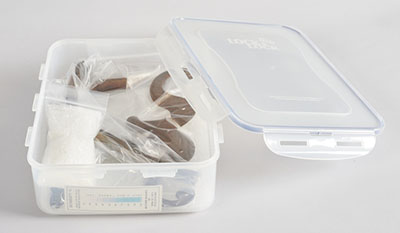
© Government of Canada, Canadian Conservation Institute. CCI 126258-0005
Figure 13. These iron objects are packed for dry storage in a food container with silica gel and an RH indicator card.
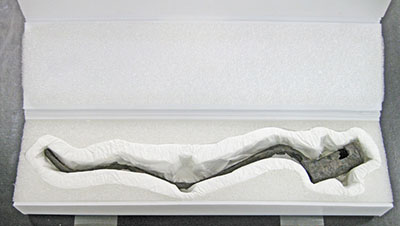
© Government of Canada, Canadian Conservation Institute. CCI 125330-0032
Figure 14. A fragile object protected from damage by being placed in a carved piece of polyethylene foam cut out to the object's shape.
Make sure to insert a humidity indicating card that can be seen inside the clear food storage container. This will provide a simple means of checking, later, if the RH conditions inside are still dry. Many versions of these cards can measure and indicate an RH as low as 10%, which is suitable for most metal storage. With time, water vapour will slowly penetrate the container and the card will indicate a gradual increase in RH. When the RH goes beyond the threshold of 10%, it is time to recondition the silica gel by drying it in an oven or to replace it with a new batch of pre-desiccated gel. Check the container periodically to figure out how long it will take before the silica gel needs reconditioning; if you find you have to recondition the silica gel too often, increase the amount of desiccated silica gel inside. The use of desiccated silica gel to protect archaeological metals must always be accompanied by a plan to monitor the desiccated environment as well as maintain it by regularly redrying or replacing the gel.
Using an anoxic atmosphere to save the Ferryland Cross
The Ferryland Cross is an archaeological composite metal object (iron, brass and gold) recovered from the Colony of Avalon, a 17th-century English colonial site located in Ferryland, Newfoundland and Labrador. This unusually shaped cross was found in the remains of a mid-17th-century forge. The general shape of a cross was apparent, but details of its composition and surface were obscured by a thick layer of corrosion, which incorporated the sand and gravel of the surrounding soil (Figure 15). Radiography revealed a complex structure that was unevenly corroded (Figure 16).
Besides iron, analysis identified gold, visible as thin flakes in the corrosion, and brass, present in one of the damaged orbs. The cross is an example of an object with multiple problems: different metals in contact, physical damage resulting from stress corrosion cracking, and the presence of salts due to the archaeological environment where it was found. The treatment of the cross involved mechanical cleaning, salt extraction and stabilization (Figure 17).

© Government of Canada, Canadian Conservation Institute. CCI 2004909-0001
Figure 15. The cross before treatment.

© Government of Canada, Canadian Conservation Institute. CCI 87826-0044
Figure 16. Radiograph of the cross, showing details of its construction and condition.

© Government of Canada, Canadian Conservation Institute. CCI 2004909-0003
Figure 17. After mechanical cleaning.
Subsequent to the treatment, active corrosion occurred. Thus, it was decided to consolidate the cross and to enclose it with desiccated silica gel in storage. The cross continued to corrode, resulting in fresh damage (Figure 18) because the enclosure had not been able to maintain a sufficiently low RH. There was an urgent need to document the condition of the cross in order to assess any future deterioration. It was also clear that enhanced storage and display conditions were required to save the Ferryland Cross. What was sought was an aesthetically acceptable, dry, anoxic and easy-to-maintain protective enclosure with a fully rounded support for display and storage at the Ferryland site.

© Government of Canada, Canadian Conservation Institute. CCI 2004909-0002
Figure 18. Detail of cracking caused by active corrosion after excavation.
Creating the support and case
In order to begin making the protective enclosure for the cross, the object was 3-D laser scanned (Figure 19) and a reproduction was made using the scanned image and 3-D printing technology.
A custom-made support was then cast in silicone rubber using the 3-D print replica as a model. The silicone rubber was poured into a form made of toy building blocks (LEGO; Figure 20). The molded support was covered with a Plexiglas case (Figures 21 and 22).

© Government of Canada, Canadian Conservation Institute. CCI 87826-0048
Figure 19. Image of the 3-D laser scan of the cross.

© Government of Canada, Canadian Conservation Institute. CCI 87826-0045
Figure 20. A 3-D printed replica of the Ferryland Cross was created from the laser scan and used to make a silicone rubber support for the object.

© Government of Canada, Canadian Conservation Institute. CCI 87826-0046
Figure 21. The empty Plexiglas case and molded support for the Ferryland Cross.

© Government of Canada, Canadian Conservation Institute. CCI 87826-0039
Figure 22. The Ferryland Cross placed onto its molded support and in the Plexiglas case.
Creating the dry anoxic environment
In order to slow down the corrosion, the cross needed to be sealed in an airtight container with oxygen and water vapour removed from the air enclosed. To create this anoxic, dry environment, the cross on its support covered with the Plexiglas case was placed within a vapour barrier bag made of Escal barrier film (Figure 23) and sachets of a water vapour and oxygen scavenger (RP-A sachets) were placed around the Plexiglas case in the bag. As the oxygen scavenger absorbs oxygen and humidity, the volume of air decreases within the bag; the Plexiglas case is therefore essential to protect the cross (without it, the cross could be crushed by the resultant vacuum pressure). The Plexiglas case also provides a flat surface that makes viewing the cross easier because of reduced glare. The vapour barrier bag was heat-sealed to make it airtight. For displaying the cross at the Colony of Avalon Interpretation Centre in Ferryland, the bag assembly was concealed by a grey frame around a window cover (Figure 24).

© Government of Canada, Canadian Conservation Institute. CCI 87826-0047
Figure 23. The empty Plexiglas case and support for the Ferryland Cross is being test-fitted in a vapour barrier enclosure (an Escal bag). The bag contains sachets of an absorber to remove water vapour and oxygen from within the enclosed environment. The bag was heat-sealed once the cross was placed inside.

© Government of Canada, Canadian Conservation Institute. CCI 87826-0049
Figure 24. The Ferryland Cross in its dry anoxic display box case at the Colony of Avalon Interpretation Centre.
This case study illustrates a few possibilities for preserving an actively deteriorating archaeological object. Here, providing good physical support was important given how the metal was fissured and fragile. Controlling the environment was essential in ensuring the longevity of the cross and was made possible by the microclimate created within the sealed protective enclosure.
Making an accurate reproduction (Figure 25) provided not only a copy that could be displayed in the open for closer examination but also a documented standard against which it will be possible to compare the original in years to come.

© Government of Canada, Canadian Conservation Institute. CCI 87826-0002
Figure 25. Plaster 3-D print, hand-painted to match the original.
More information on the treatment of the Ferryland Cross can be found in:
- Judith A. Logan, Robert L. Barclay, Charlotte Newton and Lyndsie Selwyn. "The Ferryland Cross Revisited," CCI Newsletter 36 (Fall 2005).
- Judith A. Logan, Robert L. Barclay, Paul Bloskie, Charlotte Newton and Lyndsie Selwyn. "Saving the Ferryland Cross: 3D Scanning, Replication, and Anoxic Storage," The Conservation of Archaeological Materials: Current Trends and Future Directions.
Clothing from Red Bay, Labrador
Many pieces of woollen textile and leather were recovered during the excavation of a 16th-century Basque whaling station on the Labrador coast (Figures 26, 27a and 27b). They were preserved in the wet, mildly acidic conditions of a peat bog. However, since burial was shallow, many objects were weakened by repeated freeze-thaw cycles and the presence of insects, oxygen and invasive plant rootlets. The textiles tended to be powdery and easily damaged by handling, while the leather had lost flexibility.
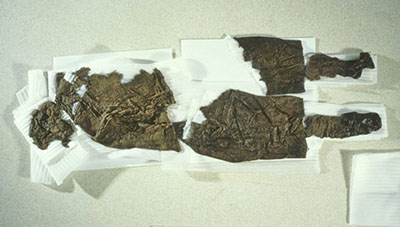
© Government of Canada, Canadian Conservation Institute. CCI 126081-0001
Figure 26. A set of clothing recovered during an archaeological excavation after preliminary cleaning onsite. The clothing includes a hat, a jacket, a shirt, pantaloons, socks and shoes.
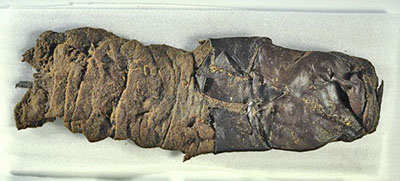
© Government of Canada, Canadian Conservation Institute. CCI 0000666-0002
Figure 27a. Detail showing the top of a right sock and shoe from an archaeological excavation on the Labrador coast.
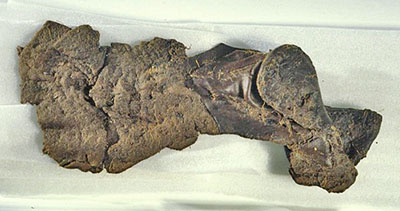
© Government of Canada, Canadian Conservation Institute. CCI 0000666-0003
Figure 27b. Detail showing the back of the left sock and shoe.
Because there are few examples of clothing from the working class from this period, it was particularly important to be able to study and analyze the objects. They were cleaned, dried and reshaped so that they could be studied by researchers (Figures 27c and 28). Using information about the fibres and construction of the clothing, accurate reproductions were made, and these are now displayed with the original objects. Textile and leather items were mounted on rigid padded supports that can be used for both display and storage and that will allow access to the objects for further study (Figure 29).
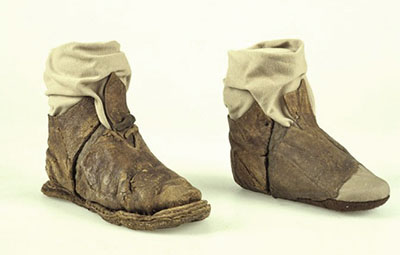
© Government of Canada, Canadian Conservation Institute. CCI 0000666-0004
Figure 27c. The shoes after treatment. They have been mounted on blocks of rigid polyethylene foam, carved to shape and covered with layers of polyester quilt batting and polyester/cotton blend knit fabric. The shoes are ready for display or storage on these mounts.
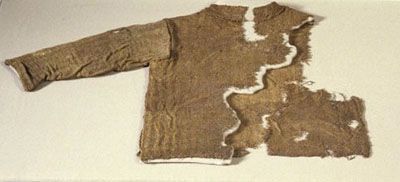
© Government of Canada, Canadian Conservation Institute. CCI 0000666-0001
Figure 28. The excavated jacket after treatment. The mount was made with a rigid paper honeycomb board, covered with polyester quilt batting and polyester/cotton blend knit fabric. A padded envelope of unbleached cotton was also made for each mount, to wrap the textile during shipping and storage.
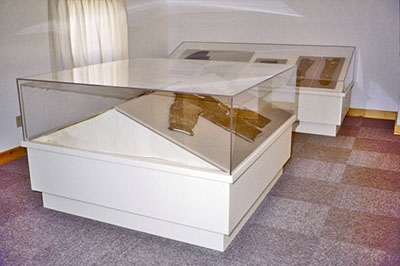
© Government of Canada, Canadian Conservation Institute. CCI 0000666-0005
Figure 29. The set of clothing from the excavation on display at Red Bay.
Bibliography
Andrews, G. Management of Archaeological Projects. 2nd ed. London, UK: English Heritage, 1991.
Brown, D.H. Archaeological Archives: A Guide to Best Practice in Creation, Compilation, Transfer and Curation (PDF format). [N.p.]: Institute of Field Archaeologists on behalf of the Archaeological Archives Forum, 2007.
Childs, S.T., and E. Corcoran. Managing Archeological Collections: Technical Assistance. Washington, D.C.: Archeology and Ethnography Program, National Park Service, 2000.
Cronyn, J.M. The Elements of Archaeological Conservation. London, UK: Routledge, 1990.
Ewen, C. Artifacts. Archaeologist's Toolkit, vol. 4. Walnut Creek, CA: Altamira Press, 2003.
Fearn, S. "Continued Studies in the Deterioration of Glass." Conservation Journal 42 (Autumn 2002).
Ferguson, L.M., and D.M. Murray. Archaeological Documentary Archives: Preparation, Curation and Storage. Paper No. 1. Manchester, UK: Institute of Field Archaeologists Paper, 1997.
Logan, J.A., R.L. Barclay, C. Newton and L. Selwyn. "The Ferryland Cross Revisited." CCI Newsletter 36 (Fall 2005), pp. 8–9.
Logan, J.A., R.L. Barclay, P. Bloskie, C. Newton and L. Selwyn. "Saving the Ferryland Cross." In E. Williams and C. Peachey, eds., The Conservation of Archaeological Materials: Current Trends and Future Directions. British Archaeological Reports, International series 2116, Oxford, UK: Archaeopress, 2010, pp. 127–134.
National Park Service. "Appendix I: Curatorial Care of Archeological Objects." (PDF format) In NPS Museum Handbook, Part I: Museum Collections. Washington, D.C.: National Park Service, 2001.
National Park Service. "Appendix E: Archeology." (PDF format) In NPS Museum Handbook, Part I: Museum Collections. Washington, D.C.: National Park Service, 2001.
Pye, E. "Conservation and Storage: Archaeological Materials." In J.M.A. Thompson, ed., Manual of Curatorship: A Guide to Museum Practice. 2nd ed. Oxford, UK: Butterworth-Heinemann, 1992.
Rimmer, M., D. Thickett, D. Watkinson and H. Ganiaris. Guidelines for the Storage and Display of Archaeological Metalwork (PDF format). Swindon, UK: English Heritage, 2013.
Society for Historical Archaeology (SHA). "SHA Standards and Guidelines for the Curation of Archaeological Collections." SHA Newsletter 26,4 (December 1993).
Sullivan, L.P., and S. T. Childs. Curating Archaeological Collections: From the Field to the Repository. Archaeologist's Toolkit, vol. 6. Walnut Creek, CA: Altamira Press, 2003.
Sustainable Archaeology. Sustainable Archaeology's Collections Procedures and Practices. Version 1.0. London, ON; Hamilton, ON: Sustainable Archaeology, University of Western Ontario; Sustainable Archaeology, McMaster University, 2014.
Walker, K. Guidelines for the Preparation of Excavation Archives for Long-term Storage. London, UK: UKIC Archaeology Section, 1990.
Watkinson, D., and V. Neal. First Aid for Finds, 3rd ed. London, UK: RESCUE – The British Archaeological Trust and United Kingdom Institute for Conservation, Archaeology Section, 1998.
© Government of Canada, Canadian Conservation Institute, 2018
Published by:
Canadian Conservation Institute
Department of Canadian Heritage
1030 Innes Road
Ottawa, ON K1B 4S7
Canada
Cat. No.: CH57-4/6-1-2018E-PDF
ISBN 978-0-660-27959-6